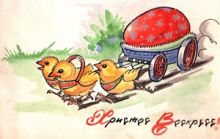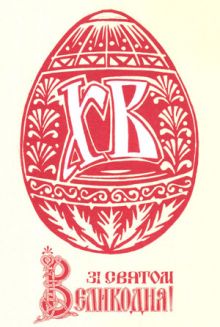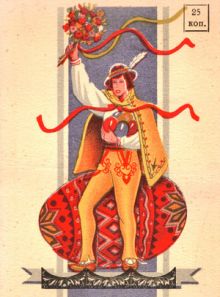There is no need to say that in the Soviet time the Easter topic was prohibited. However, our mom always cooked kutia [boiled wheat with raisins and honey. – Ed.] and uzvar [dried fruit compote. – Ed.] for Christmas, baked cakes for Easter, and brought fragrant sweetflag from Senny market for Trinity Sunday.
We still have some of our grandparents’ family postcards, in particular Easter ones. The oldest one is dated 1908: two chickens are travelling under an umbrella surrounded with the traditional heralds of spring: snowdrops and blue forget-me-nots. The second card was sent to my grandfather in 1913 when Easter was on April 14. It represents gallant gentlemen and ladies at the Easter table traditionally trying whose egg is harder. Another postcard shows the whole family: a rooster wearing moustache and monocle, a hen with a stylish hairdo and chickens with the obligatory sign: “Christ is Risen!”
During the interwar Soviet period all the religious holidays were prohibited. Even the fir was attributed to the New Year and not Christmas, not to mention Easter.
After Red Army’s victorious campaign over the river Zbruch in 1939 various editions, published before the Soviets, under the Polish rule suddenly appeared in Kyiv bookshops. There were the editions that could be easily interpreted as anti-Soviet ones, for example, openly clerical postcards. Surprised by this step taken by the authorities our father bought several Easter postcards! These colorful postcards were published in Warsaw in the 1930s and some of them are still in our family album. Their motifs were obvious: Easter eggs, chickens, and rabbits. However, our zealous booksellers hid the greetings in Polish behind vignettes and put the price of 25 and 30 kopecks. There was a talk that a large number of copies was confiscated from private bookshops in Lviv and after being properly re-designed were taken to Kyiv for sale. It was thought that the local children, raised under the Soviet rule, would take those postcards as ones for children. However, our father was very happy to return into his childhood “of the old regime” with Easter postcards.
Several years later the war started and our father was called up to the front. In Kyiv, occupied by the Nazis the religious life was resumed. The Germans closed their eyes to it and took Ukrainians’ regenerated thirst for faith as a display of anti-Soviet moods. It should be reminded that every German soldier bore the inscription “Gott mit uns” (God with us) on their belt buckle. Religious holidays were marked in the calendars published in Kyiv in 1942-43. They also published several postcards for Easter that was celebrated on April 5 in 1942 and on April 25 in 1943. I remember that adults paid attention to the symbolic color combination on those cards: blue sky above yellow clouds, blue and yellow Easter eggs nearby. On one card there was a Ukrainian girl in a wreath and embroidered shirt holding a tray with a high Easter cake and Easter eggs against the background of Dnipro River Bank landscape and St. Andrew’s Church. On another card there was a carpet, towel, Easter cakes and a jug with a greeting for our family from our friends written in Ukrainian on the back: “Happy Easter! Sending our best wishes to you! Kyiv, April 24, 1943.” It should be noted that during the war and Nazis’ occupation such things looked very patriotic! The Ukrainian way patriotic! Certain prudence with colors can be explained by the fact that in winter 1941-42 in Kyiv a lot of Ukrainian patriots were repressed; this is why the authors of the postcards could only make hints.
In the spring of 1943 my elder brother, fifteen-year-old Goga, future Honored artist of Ukraine Georgii Malakov (1928-79) remembered about the old pre-revolutionary and pre-war chickens and rabbits. Here are three chickens merrily rolling a cart with an Easter egg. And here they have gathered at the Easter table eating various dishes and... Easter eggs! I remember how much I was surprised by my brother’s joke: chickens are eating hen’s eggs! The young artist did not lack the sense of humor and drew a confused chicken looking at the rabbit hatching out of an egg! Those cards were created not for family and friends but to be sold through resellers at markets for little money to buy food.
Many years later, in the 1960s when creative people felt the fresh and life-giving breath of Khrushchev’s thaw and started sincerely expressing themselves through art, in 1964 Georgii Malakov, inspired by those feelings created a linocut of an Easter egg with a traditional abbreviation “XB.” Certainly, he did not dare to send such pictures by post and only gave them to our family and friends. Our mom always reacted to similar “risky” works the same way. She warned him: “You will be expelled from the Union of Artists!” but my brother always replied: “But look how it is done!” Only 25 years later, in the period of glasnost and decline of the developed socialism economy 50,000 copies of that postcard were published. However, the private publishing house “HGS” changed the color and added the inscription “Happy Easter!” On the back there was a text in Ukrainian, impossible in the Soviet time: “Christ is risen from the dead, trampling down death by death and upon those in the tombs bestowing life!”
Greeting family and friends with postcards nearly disappeared at the beginning of the 21st century because of high price of the cards that turned into luxurious booklets in envelopes and post service that are getting more and more expensive. All things must pass… Luckily we have pleasant memories about pleasant things.









